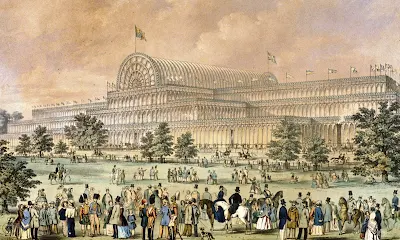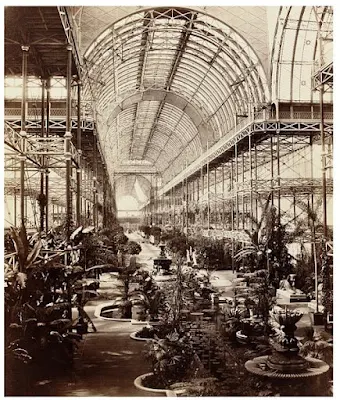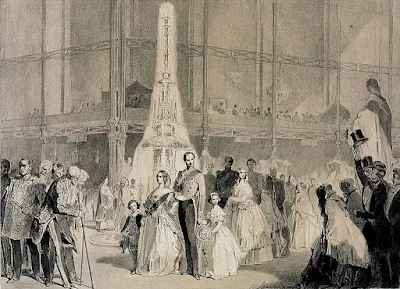The Great Exhibition of 1851 held at the Crystal Palace in London
The Crystal Palace in Hyde Park, home to the Great Exhibition of 1851
The Great Nave of the Crystal Palace, photograph 1854, Philip Henry Delamotte, V&A
The Great Exhibition took place at London's Hyde Park in 1851 inside a building called the Crystal Palace. The Crystal Palace was 1,848 feet long and 454 feet wide and covered 19 acres of London's Hyde Park. The idea for this building was the brainchild of Henry Cole. However, it was designed by Joseph Paxton head gardener at Chatsworth and close friend of John Atkinson Grimshaw. The man who would ensure this great 'happening' was none other than Prince Albert, husband of Queen Victoria. The Great Exhibition took place over five months from May to October 1851, six million visitors came to what was basically a massive trade show. There were 100,000 exhibits from all across the globe where Art and Science came together in an effort to stimulate industrial design. For instance, Fine Art objects were not permitted unless they also revealed some technical expertise. The collections were remarkably diverse, some beautiful, but others rather strange. The most popular exhibitions were those housed in the machinery court where the seemingly limitless possibilities of steam power could be seen. It was a triumphant success and so many people visited that they consumed over a million and a half buns.
The initial entrance price of five shillings for the first three weeks attracted what the Times called 'the wealthy and the gently and nobly born', but at the end of May the price was dropped to a shilling and by the time the exhibition closed in October more than six million people had visited it; a number representing about a fifth of the population of Great Britain at the time. John Tallis, who wrote a guide to the exhibition, suggested that, 'All social distinctions were for the moment merged in the general feeling of pride and admiration at the wondrous result of science and labour exhibited in the Palace of Glass. Never before in England had there been so free and general a mixture of classes as under that roof.'
The classes and the masses. Punch (14 June 1851) This picture illustrates the insistence that all classes of society were equally intent on visiting the exhibition.
Nothing like the Crystal Palace had ever been built, and skeptics predicted that wind or vibration would cause the colossal structure to collapse.Prince Albert had detachments of soldiers march through the various galleries before the exhibit opened. No panes of glass broke loose as the soldiers marched about in lockstep, and the building was deemed safe for the public. As the royal family stood on a carpeted platform in the center hall of the Crystal Palace, surrounded by dignitaries and foreign ambassadors, Prince Albert read a formal statement about the purpose of the event. The Archbishop of Canterbury then called for God's blessing upon the exhibition, and a 600-voice choir sang Handel's "Hallelujah" chorus. Queen Victoria, in a pink formal gown suited to an official court occasion, declared the Great Exhibition to be open.
The Opening of the
Great Exhibition by Queen Victoria on 1 May 1851 by Henry Courtenay
Selous. The painting shows the Archbishop of Canterbury blessing the
Exhibition. Commissioners, ministers and dignitaries surround the Royal
Family. More than 25,000 people attended the opening day. The artist
included Sir Henry Cole, later the first director of the Victoria and
Albert Museum, in the group on the left.
Her Majesty and the Princes passing through the Crystal Palace 1851 Print by H.Sharles. This lithograph shows Queen Victoria, Prince Albert and their children at the Great Exhibition of 1851. The venue was the Crystal Palace in Hyde Park, London. Prince Albert had helped to set up the Great Exhibition. He appointed the Royal Commission to decide on the content, the building and its site. Queen Victoria opened the exhibition in the purpose-built Crystal Palace on 1 May 1851.
Source
Tallis's History and Description of the Crystal Palace, and the Exhibition of the World's Industry in 1851, John Tallis & Co., 1852, from The Great Exhibition of 1851, Jeffrey A. Auerbach (1999)
Please feel free to leave comments,
Her Majesty and the Princes passing through the Crystal Palace 1851 Print by H.Sharles. This lithograph shows Queen Victoria, Prince Albert and their children at the Great Exhibition of 1851. The venue was the Crystal Palace in Hyde Park, London. Prince Albert had helped to set up the Great Exhibition. He appointed the Royal Commission to decide on the content, the building and its site. Queen Victoria opened the exhibition in the purpose-built Crystal Palace on 1 May 1851.
Tallis's History and Description of the Crystal Palace, and the Exhibition of the World's Industry in 1851, John Tallis & Co., 1852, from The Great Exhibition of 1851, Jeffrey A. Auerbach (1999)
Please feel free to leave comments,








Comments
Oh Hermes, you and me both!